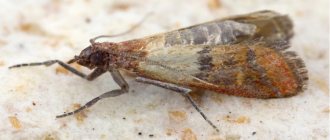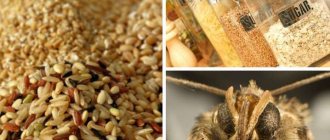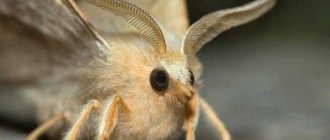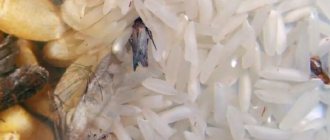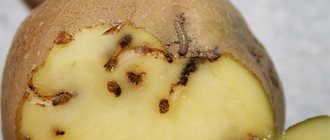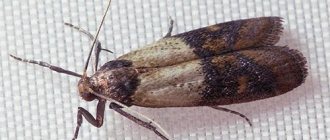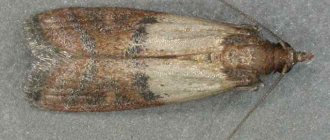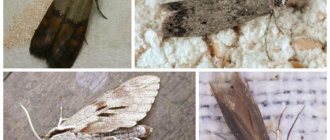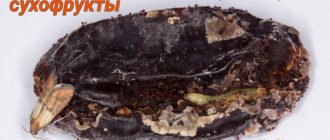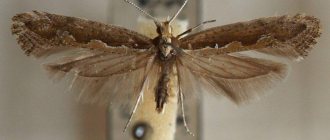Appearance and lifestyle
Name: Tomato moth, Tomato leaf miner Lat.:
Tuta absolutaClass: Insects - Insecta Order: Lepidoptera - Lepidoptera Family: Eminoptera moths - Gelechiidae
| Habitats: | garden |
| Dangerous for: | nightshade crops |
| Means of destruction: | chemical, biological and folk remedies, entomophages |
Tomato moth caterpillar.
The tomato leaf miner parasitizes tomatoes and other nightshade crops (eggplant, peppers, potatoes). This type of pest has penetrated to other continents and countries: in Russia - found in the Adygea Republic, Bashkiria, Krasnodar Territory, in Europe - in Italy, France, Spain.
The length of an adult insect is from 5 to 7 mm, gray-brown in color. The front wings have dark spots, the hind wings are dark gray with scales.
The larvae of the tomato moth, when they first emerge from the egg, are yellow; in subsequent stages of development they take on a green color with a characteristic black stripe behind the head, and closer to the pupal stage, the shell becomes pink.
Butterflies are nocturnal and hide in the leaves or grass in the morning.
Nature of damage
As with other insect pests of the large moth family, damage to human activities occurs due to the activity of the larvae. Adult tomato moths are not harmful to tomato production. The larvae, actively feeding, literally bore leaves and fruits, thereby producing extensive and deep tunnels, causing significant losses in the yield of protected and open ground.
Photos along the way will tell you what the above-ground part of plants looks like after the activity of the tomato moth.
A characteristic feature of this type of insect is that the larvae feed on mesophilic leaf tissues and, as a consequence, the formation of irregularly shaped “mines” on its surface. Therefore, the South American tomato moth is often called the tomato leaf miner. As a result, after the activity of the pest, tomato leaves begin to resemble translucent gauze, while maintaining their shape. The amount of such damage can reach up to 100%, and throughout the entire tomato growing cycle.
It is worth noting that Tuta absoluta is characterized by a fairly high ability to reproduce. One butterfly can bring up to 10-12 generations per year, under favorable conditions. In addition, larvae are extremely unlikely to enter a state of diapause as long as a food source is available.
Other characteristics of the pest’s life include the following:
- Moths can overwinter at any stage of their life cycle—egg, pupa, or adult. Although for those regions where this type of insect lives, the concept of “overwintering” is quite arbitrary, it would be more accurate to put it - to wait out the absence of tomato bushes.
- An adult female can lay hundreds of eggs during her entire life, and given the rapid maturation of the offspring, during the season one butterfly alone can bring thousands of small worms that actively eat tomato crops.
- Tomato bushes can be attacked at any stage of their growth - from seedlings to mature plants. The main thing is that there is a green mass of leaves.
- The moth attacks the apical buds of the plant, leaves, stems, flowers and fruits. In a word, the entire above-ground part of the culture, which is then, among other things, strewn with a large amount of black dried excrement.
As noted above, tomato moth pests reduce the yield and quality of tomato fruits grown in a greenhouse or in open ground. During mass attacks of the pest, tomato fruits lose their commercial value, and such losses can amount to 50-100% of the entire cultivated area.
Because the larvae are pests that often feed inside the fruit, it is difficult to achieve effective control when using chemical insecticides. In addition, the butterfly’s body is able to quickly develop resistance to various types of chemicals, therefore, as a rule, after 1-2 years, populations appear with reduced sensitivity to insecticides that were previously effective.
Life cycle and reproduction
Life cycle of a moth.
A sexually mature female can lay up to 300 eggs. The eggs are oval shaped and cream colored. After a week, larvae emerge from them.
For further development, they need nutrients; the caterpillars begin to gnaw through leaves, stems and unripe fruits. Characteristic dark spots appear on the leaves.
The development period of larvae ranges from 10 to 36 days, depending on the ambient temperature. The larvae of tomato moths exhibit their activity at a temperature of +9°C. In the final stage of development, the caterpillars leave their shelter, form a cocoon and turn into a pupa.
After about 10-12 days, the transformation process ends and the butterfly flies out of the cocoon. The lifespan of an adult insect is from 10 to 25 days.
Under favorable climatic conditions, up to 12 generations of the pest can reproduce during the season.
Dangerous Tourist: How Travelers Become Mass Murderers
Tuta absoluta is the Latin name for this insect pest that came to our latitudes from the American continent.
Inconspicuous, like all moths, it blends in with its surroundings, making it difficult to detect. This was the reason for the penetration of the South American leaf miner into Europe, both with tomatoes affected by it and on packaging and containers. The tomato moth also travels on other nightshades - potatoes and eggplants. This insect can cover relatively short distances independently with the help of passing air currents. This moth is called a mining moth because it forms so-called mines on various parts of the plant - voids in place of gnawed out parenchymal tissue. Outwardly, they look like patterned spots, and inside these passages there are pupated caterpillars. It is important to differentiate the pest in time, since the description of the mine is similar to damage caused by other insects.
The more favorable the environmental conditions (air temperature within 22-28°C, humidity up to 80%), the higher the likelihood that the pest will multiply extremely actively and, accordingly, devour tomato plantations. If, in addition, there are no natural enemies of the tomato moth, then the likelihood of destruction becomes more than real - especially considering that the females begin to mate almost immediately after leaving the cocoon, and during the season they can make at least 10 clutches of 150-250 eggs each .
This quarantine pest first tasted European tomatoes at the beginning of the 21st century, starting its catastrophic march from Spain. How Tuta absoluta crossed the Atlantic Ocean is unknown, but it was soon discovered in Holland, Germany and other countries of Eastern Europe, and then in the former Soviet republics. And wherever it appeared, the tomato plantings were destroyed at best by half, but more often the absolute mulberry, starved during the journey, attacked the tomato plantations with all mercilessness. And farmers were left to state that their crops were completely destroyed and something needed to be done.
What harm does the tomato moth cause?
Tomato moth.
To go through all stages of development, tomato moth larvae need nutrients, which they obtain from plant juices by eating leaves, stems and fruits.
Caterpillars damage the structure of the leaf, leading to its drying out, visible passages and dark spots on it, as well as to a delay in the development of the entire plant. Tomato fruits damaged by moths have their core eaten away, which leads to fungal diseases and rotting.
There have been cases of parasitism on deciduous trees. The moth mines shoots, young leaves, and buds.
Prevention of occurrence
The best method for eliminating tomato moths is countermeasures that prevent its appearance. This means that you should beware in advance of the appearance of such a dangerous enemy and create the least comfortable conditions for his stay.
- A detailed inspection of seedlings helps prevent the emergence of adults that are capable of bearing offspring.
- The slightest signs of oviposition are a reason for a methodical inspection of the leaves, which should be carried out immediately.
- Experts recommend removing damaged plants and collecting fallen leaves from tomato bushes. Then they are burned along with the larvae.
- It is recommended to carry out a preventive inspection procedure at the beginning of each season.
- Attention should be paid to both damaged tomato bushes and surrounding plants.
Note: one of the most effective drugs for combating tomato moths is halo oil; the product allows you to destroy 100% of pests.
Pest control measures
Methods for controlling tomato moth include several varieties:
- Chemical
- Biological
- Folk
- Mechanical
- Preventive.
Sticky pheromone traps.
Biologists and agricultural technicians have developed a set of measures to combat tomato leafmining moth. This means timely identification of pests and control of their numbers.
Glue and pheromone traps are used. They also carry out thorough cleaning and destruction of infected crops, change planting sites and perform fall plowing.
In winter, the greenhouse premises are cooled down; this type of moth does not have diapause and cannot withstand cold and frost; the larvae hiding in the soil die.
What are the best anti-moth products?
ChemicalFolk
Chemical methods
The ability of the larvae to penetrate deep into leaves and stems complicates the fight against them. Therefore, they use products that can seep into the plant. These include:
- Decis;
- Lannat;
- Deltamethrin;
- Actellik.
It is recommended to process in the early evening, when pests are least active. Spraying is carried out at least 6 times, observing intervals of 3-4 days. If the area is heavily infected, it is recommended to treat the soil with an aqueous solution of preparations containing pyrethrum.
Since insecticides are poisonous, it is necessary to take precautions when working with them, use gloves and masks.
Folk remedies
Chemical treatment is considered aggressive and is carried out in cases of severe plant infestation. First, it is recommended to use folk control measures.
They include:
- Hanging traps with a sticky layer of bright yellow color in the area to attract insects.
- Watering bushes with water from a hose. A stream of water knocks down female butterflies and prevents them from laying eggs.
- Collection and destruction of infected leaves and fruits.
- Visual inspection of plants, manual collection, destruction of caterpillars.
Moth damage to tomatoes. - Spraying the bushes with an extract from neem seeds, which contains the substance azardiractin, which acts on the larvae.
- Treatment of bushes with mustard and rapeseed oil. This method negatively affects the respiratory system of the larvae, they become uncomfortable, and they leave the plant.
- Orange zest and essential oil, lavender and mint sprigs are used as deterrents (it is recommended to plant bushes of these plants between tomato beds).
Biological methods of control
The bacterial composition Bacillus thuringiensis and the fungus Metarhizium anisopliae are used as biological preparations, which destroy the digestive tract of larvae and butterflies and cause death.
Also becoming relevant are such means of control as pheromone traps for adult insects and the attraction of living organisms - natural enemies of the tomato moth.
Traps can reduce the population, but not completely eliminate pests.
Alive organisms
Hedgehog flies feed on larvae.
Natural methods of combating tomato moths are to attract entomophages - insects that feed on their larvae and eggs. These are two types of bedbugs: nesidiocoris tenuis and macrolophus tais.
Adults and nymphs of this insect are voracious and are capable of destroying the eggs of the South American tomato moth in a short period of time. But you need to be careful when breeding this beetle in a greenhouse; if there are not enough victims, it damages the plants.
Good Agricultural Practices
Compliance with tomato cultivation practices has a significant additional effect in the fight against the South American tomato moth. Top of the list is growing non-nightshade crops next to tomatoes, annual deep plowing, timely irrigation, destroying affected plants and cleaning up plant debris in the fall.
Additionally, crop rotation and removal and destruction of infested plant material are important control practices that would help eradicate this pest in greenhouses.
Source
Greenhouse protection
Methods of protecting greenhouses from tomato moths include measures to prevent the appearance and stop the reproduction of pests. Follow these steps:
- Greenhouse crops are quarantined for at least 10 days before planting in the ground.
- Treat the seedlings with chamomile infusion or a weak solution of potassium permanganate.
- Insects are introduced into greenhouses and feed on the larvae and eggs of the tomato moth.
- Greenhouses and soils are treated with aqueous chemical or biological solutions against moths.
- A fine-mesh mesh is placed on the ventilation vents and the entrance to the greenhouse to prevent pests from getting inside.
In cases of severe infestation, the bushes are treated with insecticides.
Is it possible to eat tomatoes damaged by tomato leaf miner?
Of course, ideally, all tomatoes that are damaged by tomato moths should be thrown away. But not everyone is ready to so easily part with a crop that took a lot of time and effort to grow.
In principle, you can eat tomatoes that have been parasitized by the pest. Naturally, we are talking about fruits with minor damage that must first be cut out. But what you should never do is eat fruits treated with insecticides if not enough time has passed since the treatment.
What chemicals are used
Chemicals are used with caution. Strong insecticides are not recommended and should be used only as a last resort.
To combat this, you can use the drug Deltamethrin
When pesticides are used too frequently, insects develop resistance to the drug. This usually happens in the second year. The best results were shown by:
- Deltamethrin;
- Spinosad;
- Kartapa.
These drugs should not be used on fetuses. Otherwise, poisons will accumulate in the tunnels. The fruits will be unfit for consumption. When using chemicals, wear a protective gown, gloves and a mask.
It is not advisable to introduce chemicals into the soil. This is a last resort. When using medications, it is important to adhere to the recommendations indicated on the packaging. After treatment, it is better to prevent contact of animals and children with plants.
What folk methods
First of all, it is recommended to destroy all damaged plants. The bushes are collected in a heap and burned. Adhesive yellow tapes are hung throughout the area. This color attracts parasites. Once stuck to the trap, the pest cannot escape.
Moths don't like the smell of orange peels
Scatter orange peels on the garden bed. Moths cannot stand the smell of orange. Additionally, plant lavender. The parasite also does not like this aroma.
What are the main characteristics
Throughout her life, the female is capable of laying hundreds of eggs. The parasite larva is yellow in color. The size of a young individual does not exceed 0.5 mm. Gradually a greenish tint appears.
An adult representative grows up to 9 mm. The back has a pink tint. Pupation occurs. The pupa is light brown. Size – 6 mm.
Males are darker than females. Given favorable conditions, the insect creates 10-13 new generations per year. The representative is capable of overwintering at any stage of the life cycle. The reproduction process directly depends on external conditions and place of residence.
Larvae can cause serious damage to garden crops
What are the biological methods of control?
One effective way is to use pheromone traps. This allows not only to eliminate parasites, but also to prevent their reoccurrence. The use of the method in greenhouse conditions is especially important. The insect flies to the attractive smell, but is no longer able to get out.
The use of natural enemies is also acceptable. A description of the method and the main enemies are presented in the table.
| Description | The use of natural enemies is the safest method of control. There is no need to use chemicals. Enemies destroy about 90% of pests. The method is available for use. Fungi, bacteria and insects are recommended for use. |
| Main Enemies | For the fight it is recommended to use: Trichogramma; Nabis pseudoferus. |
What is the impact on the economy?
The activity of the parasite causes significant damage to plants, and therefore to the economy. Damaged fruits and seedlings have no commercial value. The farmer faces serious financial losses.
This video will tell you more about the features of the tomato moth:
According to studies, if left unchecked, the tomato moth will cause 90-100% of America's crop loss. The parasite causes the greatest damage to tomatoes and potatoes. Almost immediately after penetration into plants, external damage occurs.
There is a possibility of pockets of rotting occurring in the storage area. According to available official data, in 2009 the insect caused 100% damage to tomatoes during the winter in Valencia. Only the timely start of the struggle leads to a positive result.

